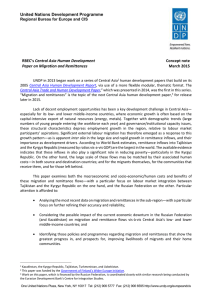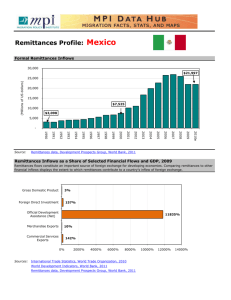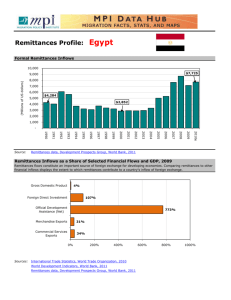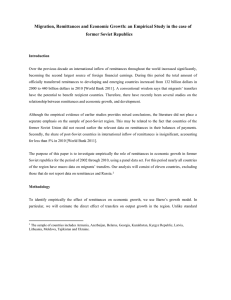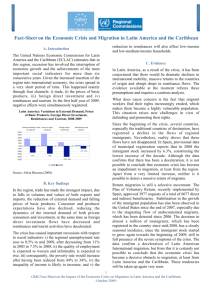Migration and the Impact of Its Remittances on Kosovo Economic... Academic Journal of Interdisciplinary Studies MCSER Publishing, Rome-Italy Ylber Prekazi
advertisement
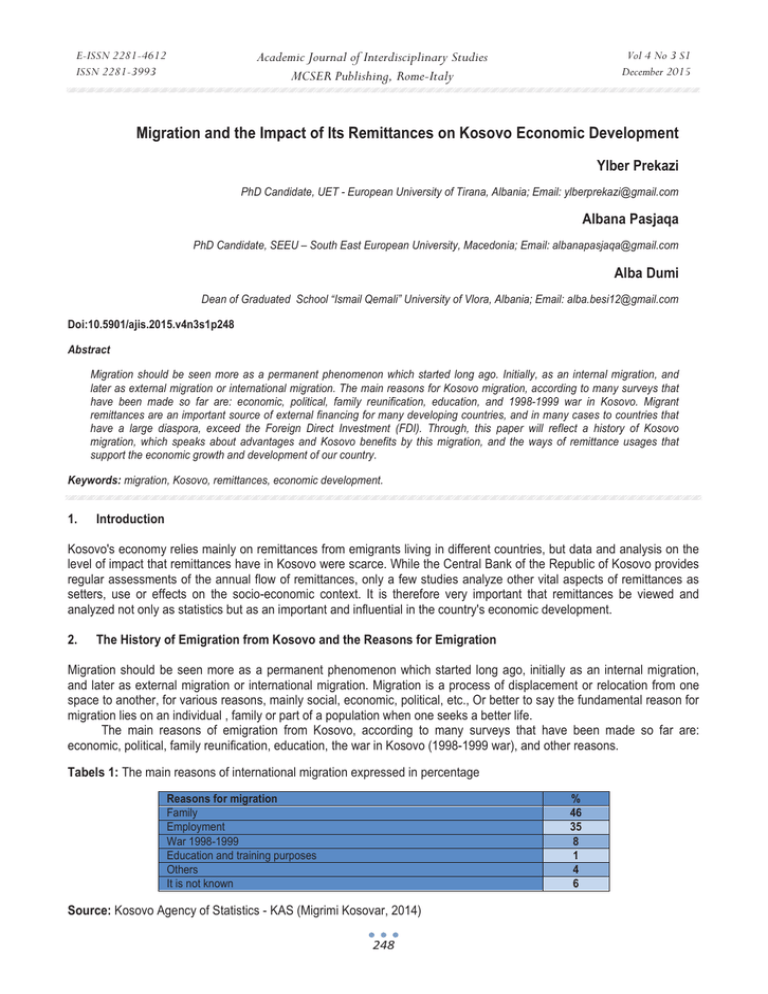
Academic Journal of Interdisciplinary Studies MCSER Publishing, Rome-Italy E-ISSN 2281-4612 ISSN 2281-3993 Vol 4 No 3 S1 December 2015 Migration and the Impact of Its Remittances on Kosovo Economic Development Ylber Prekazi PhD Candidate, UET - European University of Tirana, Albania; Email: ylberprekazi@gmail.com Albana Pasjaqa PhD Candidate, SEEU – South East European University, Macedonia; Email: albanapasjaqa@gmail.com Alba Dumi Dean of Graduated School “Ismail Qemali” University of Vlora, Albania; Email: alba.besi12@gmail.com Doi:10.5901/ajis.2015.v4n3s1p248 Abstract Migration should be seen more as a permanent phenomenon which started long ago. Initially, as an internal migration, and later as external migration or international migration. The main reasons for Kosovo migration, according to many surveys that have been made so far are: economic, political, family reunification, education, and 1998-1999 war in Kosovo. Migrant remittances are an important source of external financing for many developing countries, and in many cases to countries that have a large diaspora, exceed the Foreign Direct Investment (FDI). Through, this paper will reflect a history of Kosovo migration, which speaks about advantages and Kosovo benefits by this migration, and the ways of remittance usages that support the economic growth and development of our country. Keywords: migration, Kosovo, remittances, economic development. 1. Introduction Kosovo's economy relies mainly on remittances from emigrants living in different countries, but data and analysis on the level of impact that remittances have in Kosovo were scarce. While the Central Bank of the Republic of Kosovo provides regular assessments of the annual flow of remittances, only a few studies analyze other vital aspects of remittances as setters, use or effects on the socio-economic context. It is therefore very important that remittances be viewed and analyzed not only as statistics but as an important and influential in the country's economic development. 2. The History of Emigration from Kosovo and the Reasons for Emigration Migration should be seen more as a permanent phenomenon which started long ago, initially as an internal migration, and later as external migration or international migration. Migration is a process of displacement or relocation from one space to another, for various reasons, mainly social, economic, political, etc., Or better to say the fundamental reason for migration lies on an individual , family or part of a population when one seeks a better life. The main reasons of emigration from Kosovo, according to many surveys that have been made so far are: economic, political, family reunification, education, the war in Kosovo (1998-1999 war), and other reasons. Tabels 1: The main reasons of international migration expressed in percentage Reasons for migration Family Employment War 1998-1999 Education and training purposes Others It is not known % 46 35 8 1 4 6 Source: Kosovo Agency of Statistics - KAS (Migrimi Kosovar, 2014) 248 Academic Journal of Interdisciplinary Studies MCSER Publishing, Rome-Italy E-ISSN 2281-4612 ISSN 2281-3993 Vol 4 No 3 S1 December 2015 Graph 1: The main reasons of international migration for the period 1969-2010 (expressed in percentage) Source: Kosovo Agency of Statistics - KAS (Migrimi Kosovar, 2014) As a result of the deteriorating of political situation in Kosovo in 1989/1990 a big number of population, especially those of younger people started migrating to different European countries and a smaller proportion in the United States, but bulk of them to Europe, mainly focused in Germany and Switzerland. Of course, migration from Kosovo started earlier, and in many studies migrations are mentioned in 1960 onwards. However, the biggest waves were in 1989 and 1999. 3. The Importance of Remittances According Gëdeshi, I. (2002), one of the most important aspects of migration that has a huge economic and social impact, are remittances. Therefore, remittances represent an important aspect and have an important impact on the economy as well. Remittances are an important source of external financing for many developing countries, and in many cases to countries that have a large diaspora they exceed the Foreign Direct Investment (FDI). As shown in the tables and graphs below both indicators of importance on the economy, FDI have a decrease, compared to the increase of remittances, and present their sustainability, implying that the economy and the standard of living and consumption in Kosovo are impacted more from remittances than from foreign investment. Tabels 2: FDI and remittances in Kosovo 2007-2014 Viti FDI Remittances 2007 440.74 515.61 2008 369.86 608.72 Milion euro 2009 2010 295.45 368.51 585.70 584.33 2011 384.39 584.81 2012 229.06 605.63 2013 280.23 620.83 2014 151.30 693.68 Tabels 3: Weight percentage occupied Remittances in FDI Viti 2007 2008 2009 2010 2011 2012 2013 2014 Remittances /FDI 117% 165% 198% 159% 152% 264% 222% 458% Source: Central Bank of Republic of Kosovo 249 E-ISSN 2281-4612 ISSN 2281-3993 Academic Journal of Interdisciplinary Studies MCSER Publishing, Rome-Italy Vol 4 No 3 S1 December 2015 In most countries remittances have had a positive impact on economic growth and represent an important resource in creating economic stability and social betterment of the countries, and obviously they have an impact on the living conditions and generally increase the welfare of families recipients of remittances. The impact of remittances should be seen from the positive side but at the same time from the negative side as well. Both sides must be analyzed specifically on the impact of remittances on income and expenditure of households in the labor market, access to education, care services health, etc. Remittances according to CBK reports from 2004 until 2014 in most of the years were increasing, which in 2014 were indeed the highest with 693.7 million euros, with tendency to be even higher in 2015, based on statistics for the period January-May 2015 compared to the same period of 2014. Since the amount of money received by remittances during a year has a great role and impact and at the same time very important, decision-making institutions and policy therefore needs to create concrete strategies oriented investment projects in order to develop our economy. 4. Conclusions The role and impact of remittances depends heavily on the host country and its policies to implement, especially it consists of what monetary policy and credit applies the country, therefore fiscal policy, pricing policy and competitiveness and economic liberalization, social policy, and above all, to what extent there is a harmony between these policies. There should be a harmonization of policies within a country because only then are created the necessary and essential preconditions for the realization of economic activity of economic entities and in this context the use of remittances in investment will give an appropriate result in terms of economic growth and development. References Beilock, R. (2000), The Impact of Caring on Exchange Choices and Efficiencies: A modification of Boulding’s Three Social Organizers, Journal of Socio-Economics. CBK, (Central Bank of the Republic of Kosovo). http://bqk-kos.org/ . GËDESHI I., (2002) The role of remittances from Albanian Emigrants and their Influence in the Country’s Economy, in Kotios and Petrakos (Eds.) Restructuring and Development in Southeastern Europe, University of Thessaly Press, SEED. KAS (Kosovo Agency of Statistics), (2014) Migrimi Kosovar, Pristina. http://ask.rks-gov.net/ Rivera-Batiz, F. (2001), International Migration, Remittances, and Economic Welfare in the Source Country, Journal of Economic Studies 13, 3. 250

